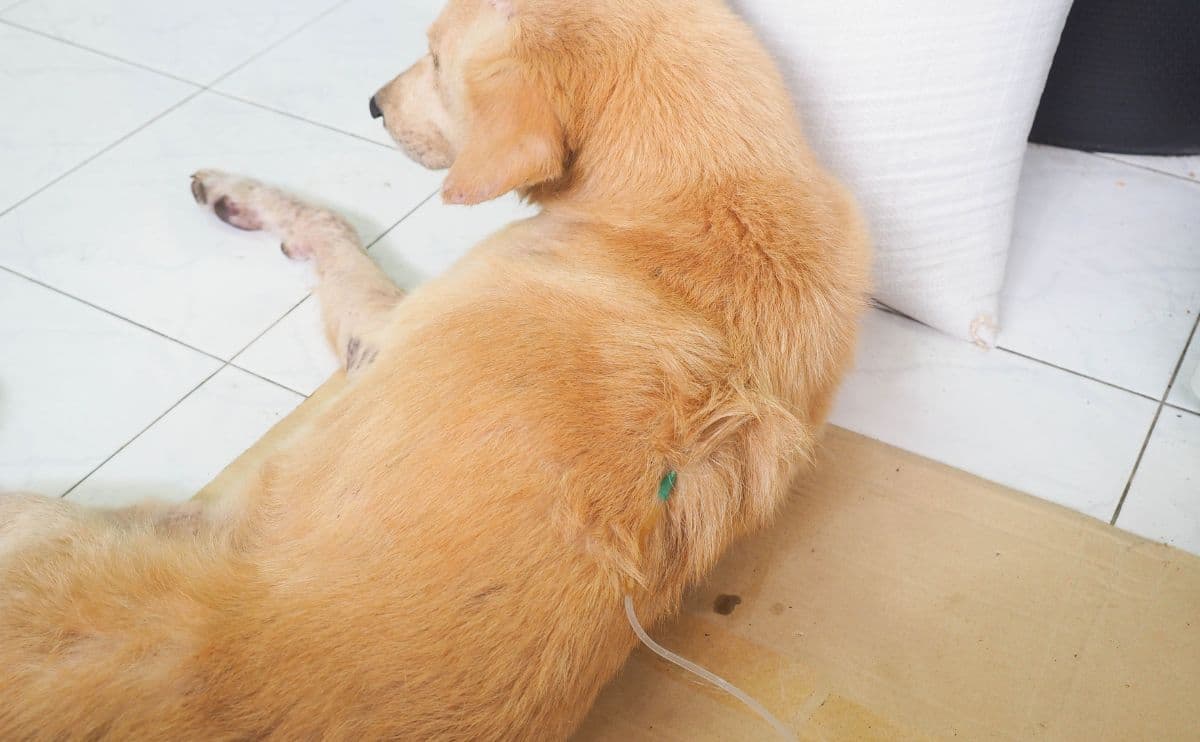When you purchase through links on our site, we may earn a commission. Here’s how it works.
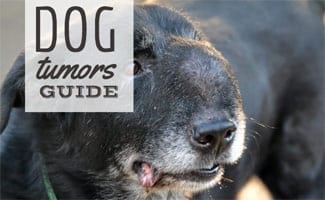
Fear sets in when you feel a lump or bump on your dog that you haven’t felt before. Thoughts of your dog having a tumor take over. But keep in mind that growths and masses are common with dogs, and not all dog tumors are cancerous.
>We’ll help answer some of your questions about the signs, symptoms, and types of tumors in dogs, as well as what to expect when you see your veterinarian — a prompt vet appointment is important with any abnormal mass or growth you notice on your dog.
What Does A Tumor Look Like On A Dog?
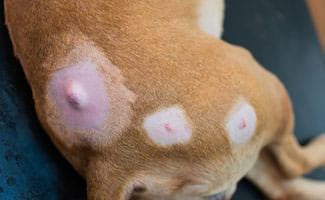
Tumors come in all shapes and sizes and can be benign or malignant (cancerous). These are the most common signs of tumors that you can detect on your dog. (Some dog tumors are internal, so you won’t be able to see or feel them.)
- A raised area on the skin or under the skin
- Can be round or have irregular borders
- Can be red or darkly-pigmented and also may bleed
- Size can range from pea-size to a much larger mass
- Can be soft or hard to the touch
Dog Cyst vs Tumor: How Do I Tell The Difference?
Cysts are fluid-filled sacs under the skin that are usually easy to move around, while tumors are typically more solid. A cyst also may drain a white, yellow, or green discharge. But it can be challenging to determine the difference. The only way to know for sure is by seeing your veterinarian.
What Are The Symptoms That It Might Be Cancer?
Several signs indicate that your dog may be dealing with cancer. It helps to be aware of cancer’s physical and behavioral signs, especially if the tumor is internal.

- Large growths
- Growths that are constantly growing and changing
- Abnormal swelling in the body
- Enlarged lymph nodes
- Sores that won’t heal
- Loss of appetite
- Weight loss
- Lethargy
- Strong odors
- Coughing or difficulty breathing
Learn more about these cancer signs in this video:
Types Of Dog Tumors
There are many different types of tumors in dogs that can occur in any area of the body, but here are some of the most common.
Mast Cell Tumor
Mast cell tumors are one of the most common malignant tumors in dogs. They most commonly grow on the skin but can also form in the internal organs. The most common locations are the limbs, chest, and lower abdomen. This type of cancer produces tumors that release the chemical histamine, which causes the tumor to be red and itchy.
These tumors originate in the mast cells and can range from low grade, where treatment is to surgically remove the tumor, to high grade, where the tumors have spread, and treatment goes beyond surgery to also include radiation and chemotherapy.
Lipoma
Lipomas are a very common benign fatty tumor that feels soft to the touch and can be moved around under the skin. This type of tumor usually isn’t a problem and is only removed if it’s bothersome to the dog. In rare cases, lipomas can be a malignant tumor called a liposarcoma.
Histiocytoma
Histiocytomas are benign tumors that mostly affect dogs under three years old. These “button tumors” are hairless, red, raised lumps that often resolve on their own within a few weeks. But some can grow quite large rapidly and become irritated, so your vet may recommend removal if this occurs.
Melanoma
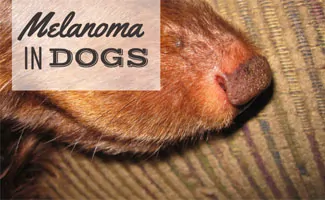
Melanoma is as much of a risk to dogs as it is to humans, although there are both benign and malignant forms. These tumors in dogs occur most often on the lips, mouth, skin, eyes, or nail bed. This tumor appears as a dark spot but can sometimes be pink, and it can be either raised or flat. Malignant melanomas can spread quickly, requiring a combination of surgery, radiation, and immunotherapy.
Lymphoma
Lymphoma is a cancer of the lymph system and is often first noticed in swollen lymph nodes behind the knees, under the shoulders, and in the jaw. A swollen lymph node can feel like a fairly hard lump that moves easily under the skin. Chemotherapy is the most effective treatment for lymphoma in dogs.
Osteosarcoma
Osteosarcoma is a painful malignant bone cancer that most often affects dogs’ legs but can occur in the hips, pelvis, or jaw. Signs include limping, swelling, and general lethargy. It’s more common in larger breeds than in small dogs.
Treatment typically includes amputation followed by chemotherapy. Sometimes amputation can be avoided by bone grafting or metal rod placement once the dog tumor is removed. This can be costly and invasive but may be worth it when considering how your dog will deal with amputation.
Mammary Gland Carcinoma
Mammary gland carcinomas are tumors that grow in the mammary (breast) tissue. They occur most frequently in female dogs, especially those who aren’t spayed or weren’t spayed until after their second heat cycle. They can feel like firm, nodular lumps underneath the skin on the abdomen, often close to the nipples. Not all mammary gland carcinomas are malignant, but surgery is required to determine whether it’s cancerous or not.
Hemangiosarcoma
Hemangiosarcomas are most often cancerous tumors on a dog’s spleen, heart, or skin. This cancer grows in the cells that line blood vessels, so there’s a high risk of rupture, which causes internal bleeding. It’s often treated by removing the tumor and then prescribing a chemotherapy regimen to reduce the risk of the cancer spreading.
Papilloma
Papillomas are benign tumors caused by a virus known as papillomavirus. They look like warts and appear around the eyes, on the lips, and inside the mouth. It can take weeks or months for these warts to go away, and your dog may be contagious during this time. Treatment is often just trying to make your dog more comfortable but may also include removal.
Fibrosarcoma
Fibrosarcoma is a type of cancer that affects the connective tissue, such as the fibrous tissue surrounding muscles, tendons, and bones, in dogs. This type of tumor is typically found in dogs that are middle-aged or older, and it can be locally invasive and aggressive.
How Do Vets Diagnose Dog Tumors?
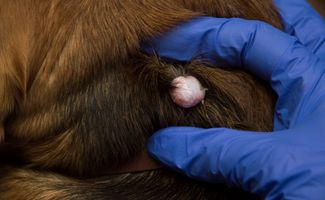
Your vet will perform a physical examination to determine whether your dog’s growth is a cyst, some other type of skin growth, or a tumor. In the case of internal tumors, blood work and other diagnostic tests can often point toward an organ that needs closer examination.
However, vets can’t definitively diagnose a dog tumor without taking a sample to inspect under a microscope. Sampling involves either a fine needle aspiration or a biopsy, and in some cases, surgery is required to obtain a sample.
Cutting The Cost Of Cancer Treatment
If you’re worried about the cost of treatment, you may be thinking about how to treat dog tumors at home. Though there may be some holistic ways to try and treat noncancerous tumors on dogs, that’s not the best choice. You need to see your veterinarian to determine what kind of tumor your dog has so they can recommend the best treatment. The best way to defray the high cost of diagnostics and treatment is by having pet insurance. You can multiple pet insurance quotes instantly below.
Pet Insurance Claim & Story
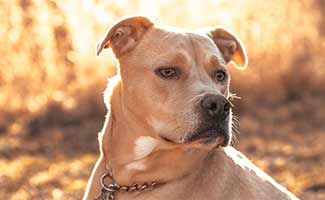
Below is a real-life pet insurance claim from a Healthy Paws customer.
- Pet: Dixie Mae (7-year-old American Staffordshire)
- Diagnosis & Treatment: 23 growths removed, not all benign
- Total Vet Cost: $15,880
- Plan Options: 80% reimbursement with $500 deductible (some pre-existing conditions not covered)
- Reimbursement: $9,577
“A couple of months ago, I noticed a small bump on her backside to the right of her tailbone,” says pet parent Susan. When the growth began to get bigger, they decided to get it checked out. The vet decided to remove the growth, but before that happened, a few more growths became noticeable. “It ended up that three of the four growths were malignant and the other one was a benign growth.”
Sometimes, when you find a growth on your dog, it can be a simple procedure to remove it. However, that’s not always the case. You may find that you need to have tests, biopsies, and surgeries to deal with the situation.
Susan says, “Given Dixie Mae’s history of skin issues, I have come to realize it is better to be proactive than reactive.” Susan inspects Dixie May regularly to stay on top of growths that arise. Over the past two years, she has had 23 growths removed, some malignant and some benign. “Having Healthy Paws Pet Insurance has enabled me to truly be proactive and have Dixie treated by the best veterinarians,” says Susan.
Learn More About Dog Lumps And Bumps
We all want to make sure we keep our pups happy and healthy. So remember, if you see or feel something abnormal, it’s always best to get your veterinarian to check it out. Dogs can develop so many different types of lumps on or underneath their skin. Some are harmless, but others require prompt treatment. Being informed and prepared will help you get the best care for your precious pup.
Tagged With: Aging, Cancer

